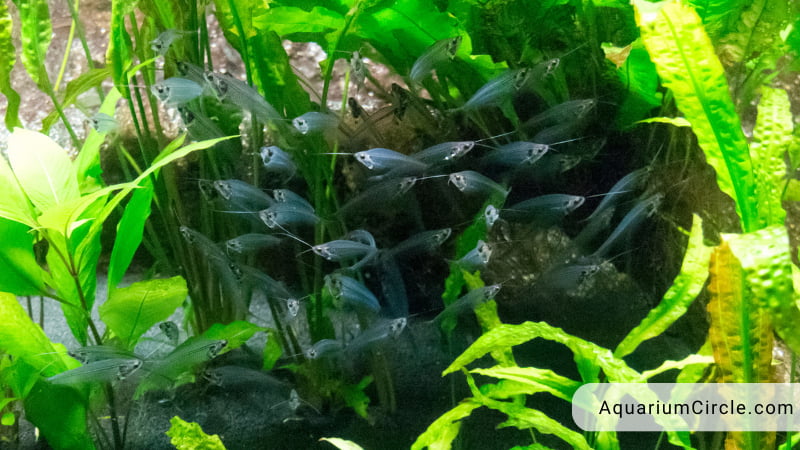Glass catfish, also known as Kryptopterus bicirrhis, are a popular and unique addition to freshwater aquariums. These fascinating fish are known for their transparent bodies that make them appear almost invisible in the water. Their unique physical features and peaceful demeanor make them a favorite among aquarists. Glass catfish are also relatively easy to care for and can coexist with other peaceful fish in a community tank.
In this blog post, we will explore the physical characteristics, habitat and behavior, feeding and nutrition, breeding, and common health issues of glass catfish to help you provide the best care for these fascinating fish. Whether you’re a seasoned aquarium hobbyist or just starting out, read on to learn more about these captivating creatures.
See also:
- Top Case: Will Different Species Of Cory Catfish School
- Panda Cory Catfish Breeding: All You Need To Know To Make It Successful
- A Good Tank With Cory Catfish And Tetras: 5 Imperative Notes
Glass Catfish Overview
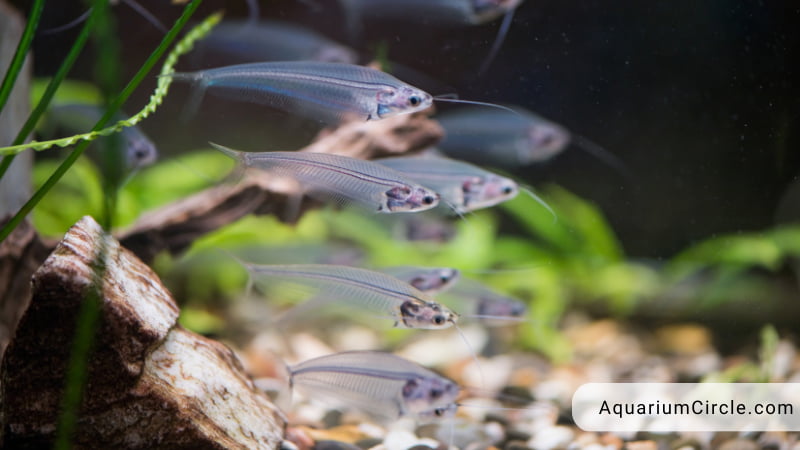
The Glass Catfish, also known as the Ghost Catfish or Phantom Catfish, belongs to the family of skeleton catfish. This family encompasses several different species, with the Kryptopterus bicirrhis being the most popular initially, but was later identified as a misidentification. The Kryptopterus vitreolus, which is suitable for beginners, is now the most popular species in the aquarium hobby. The older title of Kryptopterus bicirrhis is now reserved for the larger and more aggressive Glass Catfish, which are rare in the trade.
Glass Catfish get their name from their transparent body, which allows you to see their bones and organs. The scientific name, Kryptopterus, comes from the Greek word “kryptos,” meaning hidden, and “pterýgio” (fin). This refers to their hardly visible tail fin. Unlike most catfish that cling onto rocks or feed on the bottom, Glass Catfish are free-swimming fish that school together. They are peaceful by nature and timid, especially when first introduced to a new tank, but will become more active and rise to the middle of the tank after a few weeks.
Plants are essential for Glass Catfish as they provide hiding spots and block bright, direct light, which they tend to avoid. With proper care, Glass Catfish can live up to 8 years, bringing an amazing energy to any tank they inhabit.
Glass Catfish Physical Characteristics
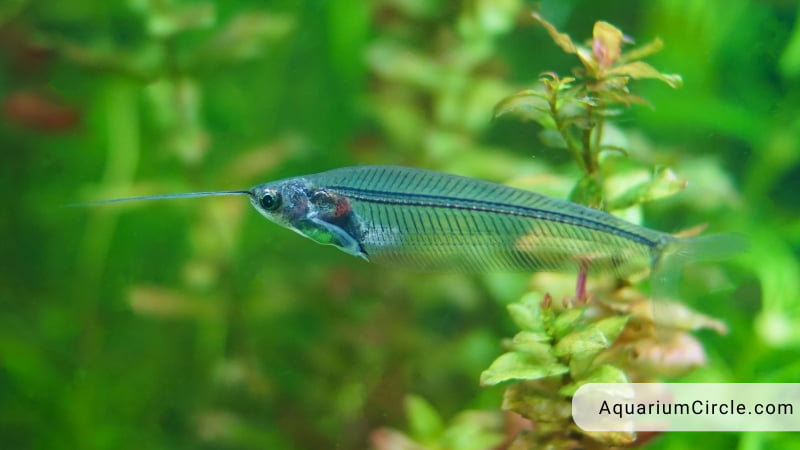
Glass catfish appearance and size
Glass catfish are known for their unique physical characteristics and transparent body that makes them almost invisible in the water. They have a slender and elongated body with a slightly flattened belly. Their body is mostly transparent, allowing you to see their bones and organs, but they have a silver or white stripe running along their lateral line from the gills to the tail. Glass catfish have two long barbels, or whiskers, that extend from their mouth. These barbels help them to navigate and locate food.
In terms of size, glass catfish are relatively small and typically grow up to 4-5 inches in length when fully matured. Juvenile glass catfish may be even smaller, around 1-2 inches in length. While they may be small in size, they are fascinating to watch due to their unique transparency and graceful movements in the water.
Differences between male and female glass catfish
Distinguishing between male and female glass catfish can be quite difficult, as they have no obvious external differences. However, there are a few subtle differences that can help identify their gender.
One of the most reliable ways to determine the sex of glass catfish is to observe their behavior during breeding. During breeding, males will chase females and display more intense colors and behaviors. Additionally, females will become more plump with eggs, which can be observed by a slight bulge in the belly area.
Another way to differentiate between male and female glass catfish is to observe their dorsal fins. Males typically have a more pointed and elongated dorsal fin, while females have a shorter and rounder dorsal fin. However, this method is not always reliable and can be challenging to discern without a trained eye.
Glass Catfish Habitat And Behavior
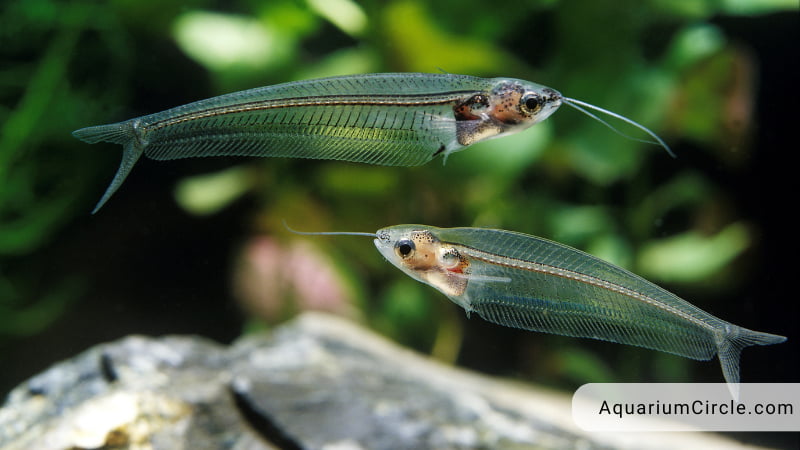
Glass catfish natural habitat
Glass catfish are native to Southeast Asia, specifically Thailand, Cambodia, and Laos. They are commonly found in the Mekong River basin and other slow-moving, clearwater streams and tributaries in the region.
In the wild, glass catfish typically inhabit areas with dense vegetation and low to moderate water flow. They are known to form large schools and swim near the surface of the water, feeding on small insects, crustaceans, and other small aquatic creatures.
The water in their natural habitat is usually soft and slightly acidic with a pH range of 6.0-7.0. The temperature of the water in their natural environment can range from 75-80°F.
Glass catfish social behavior
Glass catfish are social fish that typically form schools in their natural habitat and in aquarium settings. They tend to swim near the surface of the water and move in a coordinated and rhythmic motion, which is mesmerizing to watch.
In the aquarium, glass catfish should be kept in groups of at least five or more individuals to provide them with a sense of security and reduce stress. When kept in smaller groups, they may become skittish and hide more often, which can impact their health and well-being.
Glass catfish are peaceful by nature and rarely show aggression towards other fish, making them suitable for community tanks. However, it’s essential to ensure that they are kept with peaceful tankmates and not aggressive or territorial fish that may bully or harm them.
Glass Catfish Care (Tank Requirements, Tank Mates,…)
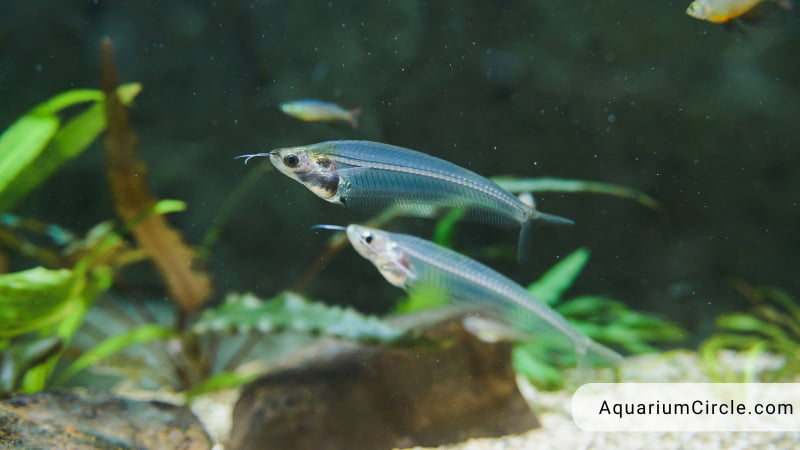
Taking care of glass catfish is relatively easy once you understand the fundamentals. There are no significant challenges that you need to overcome, but rather it’s all about being consistent and providing the proper environment, water quality, and food.
In the following sections, we will discuss the basics of glass catfish care and what you need to know to ensure their optimal health and well-being. By following these guidelines, you can help your glass catfish thrive in their aquarium habitat.
Suitable tank size for glass catfish
The minimum tank size for glass catfish is 20 gallons. This size provides enough space for a school of at least five or more glass catfish to swim comfortably and establish their social hierarchy.
It’s important to note that while glass catfish are small in size, they are active swimmers and require enough space to move around freely. A larger tank size, such as a 30-40 gallon tank, may be more appropriate for a larger school of glass catfish or if they are kept with other fish in a community tank.
Water parameters
Although caring for glass catfish is relatively simple, it’s crucial to take their strict water parameter requirements seriously. The acceptable ranges for these levels are narrow, leaving little room for error.
To maintain these parameters, you need to have a strong understanding of glass catfish and be familiar with adjusting water levels when necessary. While this may seem daunting at first, it’s a skill that can be developed over time.
If you’re not yet comfortable with maintaining these strict water parameters, it’s a good idea to start by keeping hardier fish for a while. This can help you practice adjusting and maintaining water levels without putting your fish at risk.
For glass catfish, the perfect water temperature is around 77°F, with a range of 75°F to 80°F. The pH level should be around 6.5, and the water hardness should be between 8-10 dGH.
Tank setup
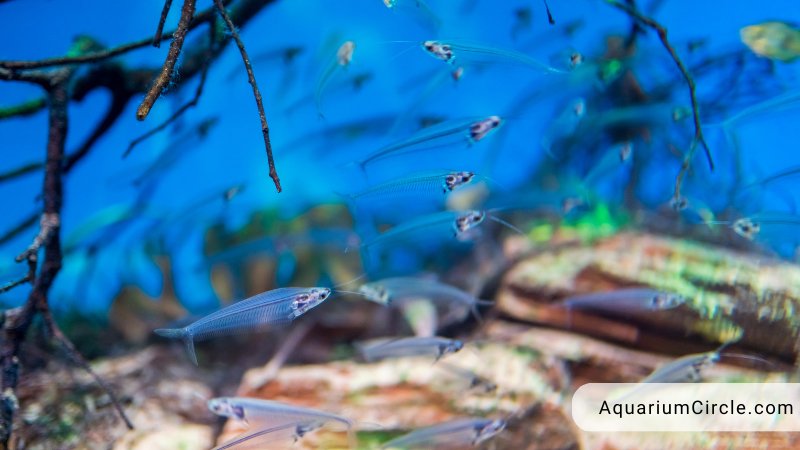
To create an ideal habitat for glass catfish, it’s important to consider their natural environment and replicate it as closely as possible.
Provide them with plenty of open space in their tank, allowing them to swim freely without feeling cramped. Avoid too many obstacles or obstructions that can hinder their movement.
Include plants in their aquarium, as they use them for hiding spots in their natural habitat. Plants like hornwort or java moss are good options to start with, as they provide shelter and comfort to the fish.
A soft substrate is also important to ensure their safety and reduce the risk of infection. Avoid using anything that can cut them and provide a sandy substrate if possible.
Lastly, consider water flow in their tank. While you don’t need to provide anything special, static water is not suitable for glass catfish. Moderate water flow is ideal and replicates the currents in their natural habitat.
Ideal tank mates
Glass catfish are peaceful fish that can coexist with other peaceful fish in a community tank. When choosing tank mates for glass catfish, it’s essential to consider their peaceful nature and avoid aggressive or territorial fish.
Ideal tank mates for glass catfish include other small, peaceful fish such as tetras, rasboras, and guppies. Bottom-dwelling fish such as Corydoras catfish or small shrimp can also be good companions for glass catfish.
It’s important to note that glass catfish can be shy and timid when first introduced to a new tank, so providing them with plenty of hiding places such as plants or decorations can help them feel more secure. Once they settle in, they will become more active and confident, swimming in schools and interacting with their tankmates.
Avoid keeping glass catfish with aggressive or territorial fish, such as cichlids or larger predatory fish. These fish can bully or harm the glass catfish, causing stress and potential health issues.
Glass Catfish Diet
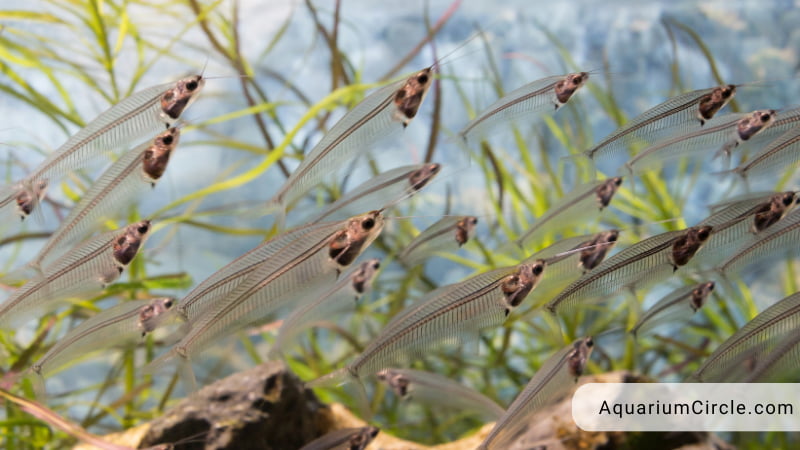
Glass catfish are omnivores and have a varied diet in their natural habitat, feeding on insects, small crustaceans, and plant matter. In the aquarium, it’s important to provide them with a balanced diet that replicates their natural feeding habits.
A good diet for glass catfish includes a combination of high-quality commercial fish food, frozen or live foods, and vegetable matter. Commercial fish food can be in the form of flakes or pellets, and should be specifically formulated for omnivorous fish.
Live or frozen foods such as brine shrimp, daphnia, and bloodworms can be offered as occasional treats or to supplement their diet. Vegetables such as blanched zucchini, cucumber, or spinach can also be provided as a source of fiber and essential vitamins.
It’s important to avoid overfeeding glass catfish, as they have a small stomach and can quickly become bloated or develop digestive issues. Feed them small portions 2-3 times a day, and remove any uneaten food after a few minutes to maintain optimal water quality.
Breeding Glass Catfish In The Aquarium
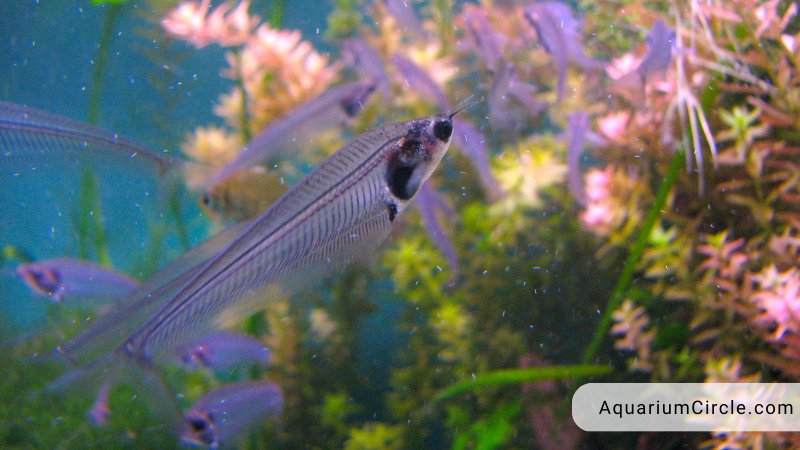
Reproductive behavior of glass catfish
Glass catfish are egg-laying fish that reproduce through sexual reproduction. During breeding, male glass catfish will chase the female and perform a “mating dance” to encourage her to lay eggs.
After the female lays eggs, the male will fertilize them externally. The eggs are usually adhesive and will attach to plants or decorations in the tank. The eggs will hatch in approximately 24 to 36 hours, depending on the temperature of the water.
Once hatched, the fry will feed on small organisms such as infusoria or newly hatched brine shrimp. It’s important to provide them with a separate rearing tank or a breeding net to ensure their safety and proper feeding.
It’s quite challenging to breed in captivity, due to requiring optimal water conditions and the right set up to encourage breeding behavior. Providing them with a suitable tank conditions, such as a planted tank with plenty of hiding places, and optimal water parameters can help encourage breeding behavior in glass catfish.
Taking care of glass catfish fry
Taking care of glass catfish fry requires special attention and care to ensure their survival and proper growth. Here are some tips for caring for glass catfish fry:
- Separate the fry: As soon as the fry hatch, they should be removed from the main tank and placed in a separate rearing tank or breeding net to prevent them from being eaten by adult fish.
- Provide a suitable environment: The rearing tank should be equipped with a sponge filter or other gentle filtration system to maintain optimal water quality. Provide plenty of hiding places such as plants or decorations to help the fry feel secure.
- Feed the fry: Glass catfish fry are small and require frequent feedings of small, live food such as infusoria or newly hatched brine shrimp. As they grow, they can be gradually introduced to small pellets or flakes.
- Maintain optimal water conditions: It’s essential to maintain optimal water conditions in the rearing tank, including a temperature of around 78°F, pH level of around 6.5, and regular water changes to ensure their health and well-being.
- Monitor their growth: Glass catfish fry grow quickly, and it’s essential to monitor their growth to ensure they are receiving enough food and growing at a healthy rate.
- Gradually increase the water flow: As the fry grow, gradually increase the water flow in the tank to help them develop their swimming ability.
- Consider adding aeration: Adding aeration to the rearing tank can help provide additional oxygen to the water and support the growth of happy and healthy fry.
Glass Catfish Common Health Issues
Glass catfish are generally hardy fish, but they can be susceptible to certain health problems. Common health issues that glass catfish may encounter include:
- Ich
- Fin rot
- Dropsy
- Swim bladder disease
These health issues can be caused by poor water quality, overfeeding, or other stress factors. Preventing these health issues requires providing the glass catfish with optimal care, including maintaining good water quality, feeding a balanced diet, and monitoring their behavior and appearance for any signs of illness. Regular water changes and providing a suitable environment with plenty of hiding places can also help prevent stress and promote their overall health and well-being.
Video About Glass Catfish
FAQs
How big do glass catfish get?
Glass catfish typically grow up to 4-5 inches in length.
What do glass catfish eat?
Glass catfish are omnivorous and feed on a variety of foods including small live or frozen insects, crustaceans, and vegetables.
Can glass catfish live with other fish?
Yes, glass catfish are generally peaceful and can coexist with other peaceful fish in a community tank.
What is the ideal tank setup for glass catfish?
The ideal tank setup for glass catfish includes a minimum tank size of 20 gallons, plenty of hiding places, and a soft substrate. The water should be kept at a temperature between 72-78°F and have a pH between 6.0-7.5.
How do glass catfish breed?
Glass catfish lay their eggs in plants or on the substrate. The eggs hatch in 24-36 hours and the fry are free-swimming in about 5-7 days.
References

Annette M. Chaney is an experienced marine biologist with over 20 years of experience as an aquarist and fishkeeper. She started her first aquarium at a young age, filling it with frogs and goldfish obtained from the ten-cent pet store.
Annette grew up caring for and breeding African Cichlids, which led to a hobby in high school that doubled as a profitable means. Attending Reed College gave her time to solidify herself as an accomplished aquarium caretaker with an eye for sales. After that, from 2009 – 2013, she studied at Roger Williams University – one of the most prestigious universities for Aquaculture and Aquarium in USA. She is the founder of AquariumCircle since 2010.
